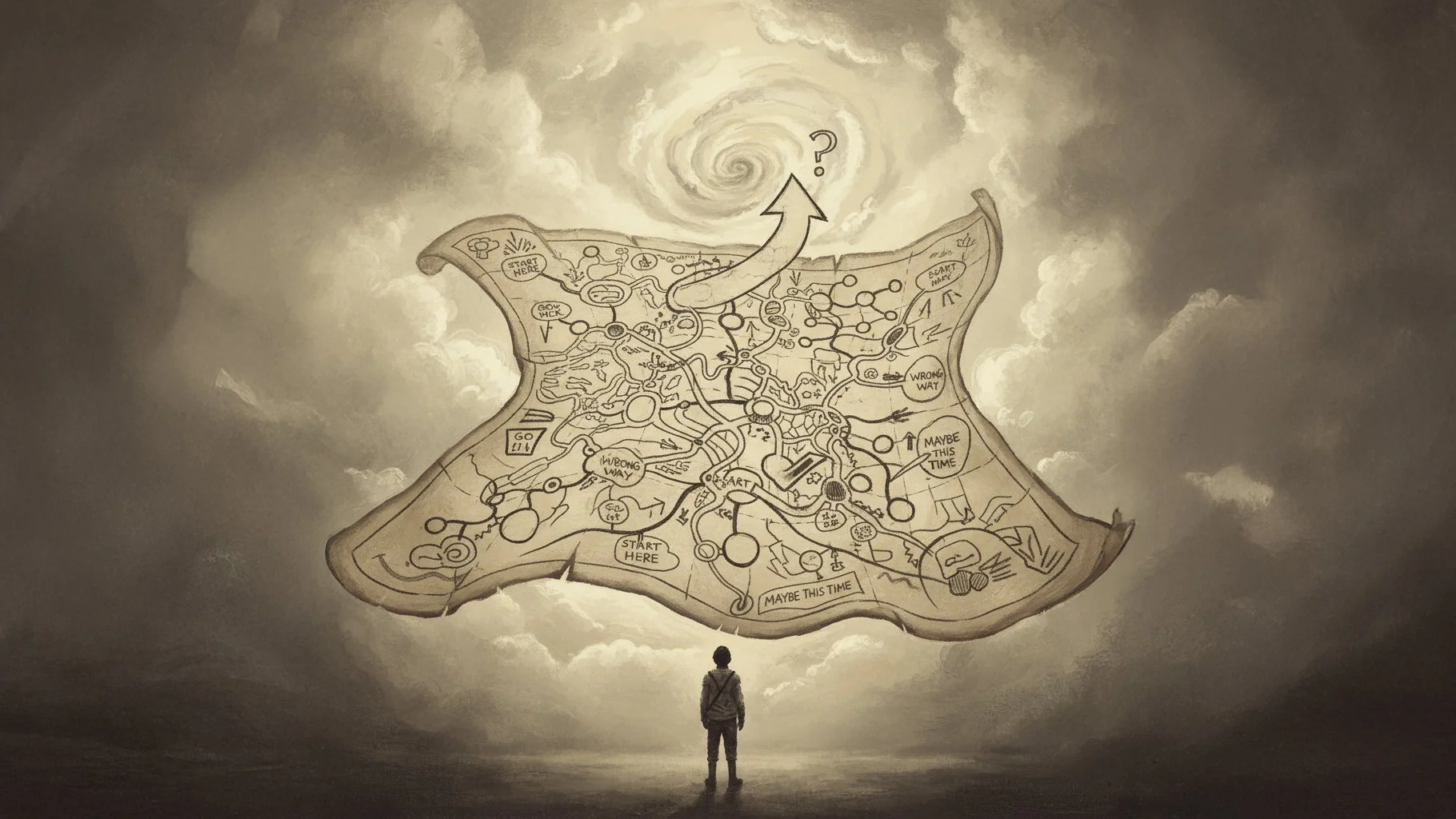Why I Ditched Long-Term Goals
Mathew Dalby on trading decade-long plans for 12-month focus. Why short-term goals build momentum, creativity, and joy — and how StudioFAB thrives on quick, sharp projects.
The Big Plan Illusion
For years, I adored a grand plan. The ten-year strategy. The whiteboard full of arrows. The “by the time I’m fifty, I’ll have…” list.
But here’s the quiet truth I’ve learned: long-term goals are often fool’s gold.
They sound noble, but they dangle just far enough away to keep you forever reaching, never arriving. You chase something so distant that you stop noticing the side quests — the unexpected turns, obsessions, people, or ideas that might’ve become something extraordinary if you weren’t so blinkered by your plan.
The Power of the Side Quest
History’s full of proof that detours can be more fruitful than destinations.
Columbus set out for India and found the Americas.
Fleming was trying to grow bacteria and stumbled upon penicillin.
Percy Spencer was testing radar equipment when a chocolate bar melted in his pocket — and voilà, the microwave was born.
None of them were following a decade-long roadmap. They were curious, awake, and paying attention to the world as it actually was, not how they’d planned it to be.
StudioFAB and the Short Game
At StudioFAB, we see the same thing in design.
Everyone loves the big projects — the ones that take years, a small army of consultants, and entire walls of drawings. And they’re brilliant, of course. But the short, sharp ones — the pop-up competition entries, the rebranding sprints, the one-off hospitality refreshes — those are where we stretch a different set of muscles.
They demand focus, speed, and instinct. You make decisions fast. You trust your gut. You find clever shortcuts. You rediscover agility. And sometimes, you surprise yourself with how inventive you can be when you don’t have the luxury of time.
Necessity is still the mother of invention.
Give me half a dozen quick, compact projects over one big behemoth any day. They keep the studio nimble, creative, and alert — and they remind us that brilliance doesn’t always need a three-year timeline or a $30 million budget. Sometimes it just needs a spark, a deadline, and a good cup of coffee.
Why Short-Term Wins Matter
These days, I set twelve-to-eighteen-month goals.
Tight, focused bursts. Something I can define, touch, complete. Then move on.
The win is real. The progress visible. The energy stays alive.
You learn faster, adapt quicker, and avoid the emotional fatigue of chasing a horizon that never gets closer. Small goals keep your momentum human — fast enough to feel progress, slow enough to notice the scenery.
Myopia and Missed Sunsets
When you live in long-term goal mode, you risk a kind of blindness. You’re so fixated on the destination that you miss the texture of the journey — the people you meet, the moments of calm, the small wins that quietly build a good life.
Let’s not trade every sunrise and sunset for a dream that might never deliver what you think it will.
Because those are the real dividends — the ones you don’t see until you stop staring at the far-off peak and notice the light on the horizon.
Small Stones, Big Path
Enough short-term goals, stacked with intent, tend to form a long-term one anyway.
But you’ll have lived far more of your life getting there.
No decade-long manifestos. No “vision boards for 2035.”
Just the next clear, achievable thing — done properly, with presence, and a little joy along the way.
You can keep chasing the summit if you like.
I’m happier building the path — one small, beautiful stone at a time.
The Gift of Constraint (and Why Perfection Needs a Good Kick in the Shins)
We tend to treat constraints as enemies — the budget too small, the site too narrow, the client too picky. But limits don’t kill creativity, they ignite it. The best work happens when you stop trying to do everything and start focusing on what matters. Here’s how structure, restraint, and a touch of discomfort can turn frustration into innovation.
“The very things that held you down are gonna carry you up and up and up!”
In the summer of 1501, Florence was facing a very Italian problem. Lying flat in the cathedral courtyard was a massive slab of marble, abandoned by two sculptors and described rather tragically as “a certain man of marble, badly blocked out and laid on its back.”
You can picture it, can’t you? A once-promising block, left sunburnt and pigeon-kissed, a sort of marble roadkill in the Renaissance sunshine.
For forty years, it sat there, too flawed to use and too precious to throw away. Then along came a 26-year-old sculptor, barely out of artistic adolescence, and with the sort of misplaced confidence we usually associate with first-year architecture students.
He took one look and said, “I’ll take it.”
The marble was awkwardly narrow, riddled with veins, and so brittle it made everyone nervous. But instead of fighting against the constraint, the sculptor leaned into it. The slab dictated the pose, the tilt of the head, even the famously oversized right hand — all the product of necessity rather than whim. The sword and Goliath’s head? Not missing, merely uninvited. There simply wasn’t room.
The sculptor was Michelangelo, and the sculpture was probably the most famous piece in the world, David.
It was the world’s greatest case of make-do and mend.
When finished, the statue was so magnificent (and so heavy) that the cathedral roof creaked at the thought of it. A committee — including Botticelli and Leonardo da Vinci — sensibly decided it would look far better on the ground, preferably where people could actually see it. And there it stood, redefining sculpture and proving once and for all that constraints don’t strangle creativity, they sculpt it.
Oh, yeah, his right hand is too big!
Constraint: the secret ingredient
As designers, we tend to groan when faced with limitations. Budgets, deadlines, local council guidelines written by people who have clearly never designed anything in their lives — all of it can feel maddening. But here’s the thing: creativity without constraint is chaos.
A blank page offers infinite freedom, which is another way of saying endless panic. Give that same designer a boundary, and they’ll turn into MacGyver with a mood board.
The value of design lies as much in what you leave out as what you put in. A great space breathes because you resisted the urge to fill every corner. A great idea sings because you stopped one verse earlier than expected.
Think of the Japanese haiku: seventeen syllables to express an entire season, a lifetime, or the unbearable tenderness of a falling leaf. Limitation, as it turns out, is poetry’s favourite muse.
Dr Seuss knew it, too. Challenged to write a children’s book using no more than fifty words, he produced Green Eggs and Ham, which went on to sell two hundred million copies. Proof, if ever you needed it, that being boxed in sometimes helps you think outside it.
The illusion of certainty
Our modern brains despise uncertainty. They rush to fill the silence with assumptions — quick, comforting, and often wrong. Psychologists call it confirmation bias. I call it creative taxidermy: everything looks alive, but nothing’s actually moving.
So, how do we keep the work alive when the unknown is breathing down our necks?
First, use three kinds of thinking in sequence, not all at once
Divergent thinking. Open the windows. Generate options, variations, and delicious oddities. Quantity before quality.
Convergent thinking. Close the windows. Sort, cluster, compare, and choose. Commit to a path.
Metacognition. Step onto the balcony. Notice how you are thinking, not just what you are thinking. Plan, monitor, and adjust your own process.
Now, give that trio a practical runway.
Do not sprint to a solution. Define the shape of the problem. Clarify the outcome you actually need. Write the challenge in one clean sentence. Then write the best-case scenario in one more. If it takes three, you do not yet understand it.
Remove assumptions. Make a list of everything you think is true. Cross out every line that you cannot back with evidence. Keep only facts.
Work the classic questions. What, Why, Who, When, Where, and How. Simple questions, ruthless discipline.
Ask Why, then Why again, and again, until the root presents itself. The Five Whys originated as a Toyota habit and remains an elegant way to dig beyond symptoms and uncover their causes.
Balance collaboration with solitude. Invite the room to diverge, then give people private thinking time before you converge. It reduces the risk of homogeneity, that slow drift toward agreeable mush. In the literature, it is referred to as groupthink, where the desire for harmony stifles alternatives. Do not let a tidy meeting strangle a good idea.
Test head and heart. Give each option a simple score out of ten for logic and a simple score out of ten for feeling. If the numbers wobble, you probably need to refine the brief or push the idea further out to the edge and bring it back with something worth keeping.
Once the shape is finally visible, create a plan. One page. Milestones, owners, and a date when you will judge success with cold eyes.
Extra Courage required?
And if you want a little courage for the road, remember a few true tales of persistence under constraint. Dr Seuss wrote Green Eggs and Ham using only fifty distinct words after a fifty-dollar bet from his publisher, and it became his most successful book—constraint in action.
J K Rowling’s first Harry Potter manuscript was turned down again and again before Bloomsbury said yes, a reminder that rejection often signals timing, not talent.
Angry Birds was not a first swing; it was Rovio’s fifty-second game, the one that kept the lights on.
As for Walt Disney, people often quote a specific tally of rejections, which is difficult to verify. What is clear is that many investors passed before television, money, and banking partners backed the park, and that is the part that matters for us.
The stuff of dreams OR that nightmares are made of…
“The right yes is often later than you expect. ”
Creativity does not live in knowing. It lives in not knowing. It is the delicate wobble just before a form reveals itself. It is stepping out on thin ice and listening to the cracks grow louder, until you finally break through and feel the cold bite of something real. That is the point. That is where ideas breathe.
So, the next time you are staring down a tight budget, a contrary site, or a brief that reads like a riddle inside a spreadsheet, do what Michelangelo did with his ill-tempered marble. Use it. Shape with it. Let it answer back. Your constraint is not an obstacle. It is the chisel in your hand.
Perfection is overrated. A little pressure never hurt a masterpiece.









